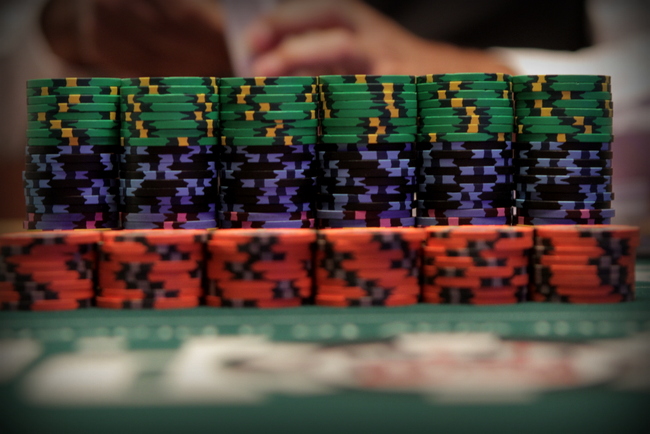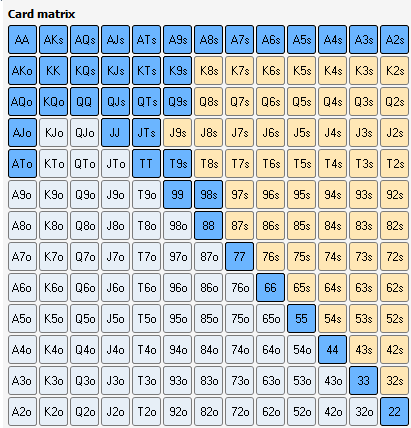Advanced Texas Holdem Tournament Strategy
Ultimate Texas Holdem Strategy Guide: Rules for Winning
Play Good Cards and You Will Win. My #1 Texas Holdem tip is one of the very first. This advanced tournament article is meant for those players who are already familiar with playing tournament poker and specifically no limit MTT games. The concepts covered in this guide will refer to advanced terms and concepts like folding equity, position, image and implied value.
Don’t let the above title fool you – there’s no way to guarantee a profit in any casino game. But if you play your cards right, a good Ultimate Texas Holdem strategy can drop the house edge to 0.526%. Play it wrong, and the house edge will start at 2.85%, increasing with every bad decision made.
The first thing you need to know is that there’s a big difference between Texas Holdem Poker and Ultimate Texas Holdem. The former is a player-vs-player game that often involves bluffing and outwitting your opponents through mental aptitude.
Despite its similar appearance, Ultimate Texas Holdem is completely differently. This is a house-banked game that offers to such psychological advantage. It’s player-vs-dealer, and only the best hand wins. Therefore you’ll need a completely different Ultimate Texas Holdem strategy to win more often.
Ultimate Texas Holdem Rules
The rules of the game are simple, especially if you already know how to play Texas Holdem poker. Here’s a quick rundown of game play.
– 1 standard 52-card deck I used, reshuffled after every hand.
– Player makes equal Ante and Blind bet to start.
– Player and dealer each dealt 2 hole cards (face down); player may look at own cards.
– Player will either Check or Raise, with Raise equal to 3x or 4x the Ante.
– Three community cards are dealt (face up).
– If Player checked before, he may Check again or Raise 2x the Ante. If a Raise was already placed, no further bets can be placed.
– Final two community cards are dealt.
– Player must Raise equal to Ante if he’s checked on both previous rounds, or Fold. If a Raise was already placed, no further bets can be placed.
– Player and Dealer set highest ranking hands from their own hole cards and community cards.
– Highest ranking hand wins. Dealer must have Any Pair or better to “qualify”.
Ultimate Texas Holdem Payouts
Remember, there are three bets that may (or may not) win here; the Blind, the Ante and the Raise. The relative payouts and dealer hand qualifications are as follows.
– If the Player wins and the Dealer qualifies, Blind, Ante and Raise bets win.
– If the Player wins and the Dealer does not qualify, Blind and Raise bets win; Ante is a push.
– If the Dealer wins and qualifies, Blind, Ante and Raise bet are lost.
– If the Dealer wins and does not qualify, Blind and Raise bets are lost; Ante is a push.
– In the case of Tie, all bets push regardless of dealer qualification.
Blind Bet Pays: Ante and Raise bets are always paid even money. Blind bets pay according to the following pay table, based on the player’s progressive hand ranks.

– Royal Flush Pays 500 to 1
– Straight Flush Pays 50 to 1
– Four of a Kind Pays 10 to 1
– Full House Pays 3 to 1
– Flush Pays 3 to 2
– Straight Pays 1 to 1
– All Others are a Push
Ultimate Texas Holdem Strategy

The biggest takeaway from the rules section is that the amount a player is allowed to Raise will decrease with each passing round of play. Either way, a Raise (aka Play Bet) must be made at some point, or the player must fold.
There’s a very basic chart players can use to ensure they are always making the right move. Note that this is an Ultimate Texas Holdem strategy for beginners, and that more advanced tactics can be applied later.
Note: If you’re dealt a pair in the hole, always Raise pre-flop unless they’re 2s (Raise after flop if 2s). For all other hands, follow this Ultimate Texas Holdem strategy chart. If your hand still falls into the “N” column after all community cards are dealt, fold.
Low Card | |||||||||||
2 | 4 | 6 | 8 | 10 | Q | ||||||
A | Y | Y | Y | Y | Y | Y | |||||
S | S | Y | Y | Y | Y | ||||||
N | N | S | Y | Y | |||||||
J | N | N | N | S | |||||||
10 | N | N | N | N | |||||||
N | N | N | N | ||||||||
N | N | N | |||||||||
7 | N | N | |||||||||
6 | N | N | |||||||||
N | N | Yes, Raise | |||||||||
N | N = | ||||||||||
3 | S = | ||||||||||
Best Overall Canadian Casino with Easy Deposits : Royal Vegas
Royal Vegas, the leading Canadian gaming brand, are really going out of their way this month and offering a very lucrative offer to prospective players. Details inside.
Related posts:
You are Now Starting: Unit 5 – Advanced Poker Strategy
In this final unit we are going to start to take your strategy to a higher level by introducing some advanced poker strategies and concepts which you can incorporate into your new poker strategy that you have learned so far in this course.
We are also going to complete the Poker Bankroll Challenge and our goal of turning your initial $25 stake into a bankroll of $1,000. This new bankroll will then provide you with the funds to compete at the higher stakes table on an ongoing basis and the sky is the limit on the amount of profit you can earn going forward.
So far the strategy we have taught you is solid and should be profitable if executed correctly.
A-B-C poker is great for the lower stakes tables, but as you move up the stake levels and start to face players with a higher standard of play and experience, then you will need to take your strategy to a more advanced level.
This not only gives you more weapons in your Arsenal to use, but it will also help you to understand when some of these advanced concepts and moves are being used against you and the best way to counteract them.
We are only going to scratch the surface of advanced poker strategy in this unit. Poker is a constant learning process and we will continue to cover more advanced topics in other courses which you can take once you have completed this one.
Lets start by looking at some general advanced poker concepts…
Know When a Player is Pot Committed
Always be aware of your opponent’s chip stack and whether they have become pot committed.
When we say a player is pot committed we mean that he has already committed a significant portion of his stack into the pot, and that he is unlikely to fold now, because he would be left with too low a stack.
Usually if a short stacked player has more than half his chips committed before the flop then he is pot committed. The chances are he’ll either raise all-in before the flop if given the chance or move all in after the flop whether he has hit his cards or not.
Never try to bluff in this situation, as it will be very hard to chase them out of the pot, there’s no point in bluffing if your opponent is not going to fold.
However this also provides an opportunity, by knowing that our opponent is pot committed, we know that there is a good chance that he is betting with a weaker hand than normal, so it allows us to relax our hand requirement a little to call with a more marginal hand and still be confident that we are in the lead.
Responding to a Raise
In the situation where you are involved in a pot and someone raises behind you it is never an easy answer on what you should do. It depends a lot on the size of the raise and the situation at the table.
So there are no hard and fast rules on whether you should call a raise but there is a thought process that you can work through in order to make your decision:
- Your Hand – did you come into the pot with a solid hand or did you enter with a marginal hand?
- How many players were in the pot when the raise came in? – a raise against one player shows less strength than a raise against multiple players.
- How many players are yet to act? – a raise from the dealer button or blinds may just be an attempt to defend the blinds or foil a steal, whereas a raise from a player in early or middle position indicates a lot more strength.
- Will you have position on the raiser after the flop? – if they are one of the blinds then you will have position after the flop so this can allow you call with a slightly more marginal hand.
- How aggressive is the raiser? – a more conservative player should be given more respect for a raise than an aggressive player although don’t just assume that an aggressive player is bluffing – remember – he may have a solid hand just as much as you.
- What are the pot odds? – you should be more willing to call a raise with good pot odds than one with bad pot odds
- Your stack – are you approaching being short stacked? Have you got time to turn this opportunity down and wait for a better opportunity to get your chips into the pot, or are you in situation where if you folded here, you would be forced shortly down the line to put in your chips in a weaker situation that this one due to your short stack.
If you work through the above factors then it should help you to make an informed decision on whether to make the call or not.
Showing Hands

If you win a pot before the showdown, then you have the option to either muck your cards (without revealing them to your opponents) or to show the hand before you muck, thus revealing the hand you had.
Most internet poker rooms give you this option, with two buttons that will popup with an option to show your cards, after you have just won a pot by your opponent folding.
I see a lot of beginner players showing their hands, and most of the time this really is a mistake. Why? Because you are are giving free information to your opponents about the actions you took with that particular hand or type of hand, it helps them to read your future actions.
The general rule is to not show your hand unless you have to – stick to this, there is no need to give additional information to your opponent if you don’t have to.


However, even though you are not going to use this tactic in your strategy you need to be aware of it, and why other people might do it. Every time an opponent shows us their hand we are going to pay a lot of attention to it, and then walk through the actions they took throughout the hand to help us spot betting patterns and read our opponent in future hands.
But we can’t automatically assume that those patterns will repeat in the future, and you need to understand the reasons why someone might have shown their hand.
Players who show good hands are either
- Overexcited at getting a big hand and not getting a chance to show it or
- They are showing you a good hand so that next time they want to steal the pot you give them more respect because they have shown you that they raised with a good hand.
Players who show bluffs are either
- Trying to temp you into tilt mode or
- Trying to get you to jump to the wrong conclusion – the next time they make a raise the chances are they’ll have a good hand, and because you’ve seen them bluff the pot, they are hoping that you jump to conclusions and assume that this is just another bluff and call with a weakened hand.
Generally you will be able to judge the above based on how good the player is, and whether they are capable of advanced moves like this designed to trick you.
Back to the statement of “Poker being a game of information”, yes we are constantly trying to interpret the information that our opponents gives us, but also you can control the information that you send out to opponents as long as you are aware of what information they have received and how you can use that against them by reversing the story next time you are in a pot with them. Keep them guessing and keep control of your information flow and you will be the one in control.
Advanced Texas Hold'em Tournament Strategy
Time to Up the Stakes
You are nearing the end of the course and so it is time that we again stepped up our efforts to reach our goal of $1,000 from an initial stake of $25. Your bankroll should now be over $200 and things will start to move quite quickly from now with just 4 more stages of the challenge remaining before you hit your goal of $1,000.
So far you have learnt a solid basic strategy and built upon that with some advanced strategies. You now know the process and tools required to make all your poker decisions.
We are going to move away from the 5c/10c tables and on up to the 10c/20c tables for the next few stages. Again you may see a slight improvement in the quality of opponent, but there are still plenty of bad players at these stake levels.
Don’t be intimidated by the increase in stake level but as usual be cautious when you first start until you get used to any differences it may present. Remember the amount of the bets and raises will go up in line with the increase in stake levels, but the maths and our strategy remains the same. There will still be plenty of fish at this level, but there will also be a few more better players thrown into the mix as well.
Now we’re moving onto bigger stake levels, make sure you do not stray from your strategy at all, any mistake will have a bigger dent on your bankroll at higher stake tables. Just play how you have learnt and practised throughout this course and remember the returns from a higher stake table are also more!
Poker Bankroll Challenge: Stage 9
Texas Holdem Poker Strategy Tips
- Stakes: $0.10/$0.20
- Buy In: $20 (100 x BB)
- Starting Bankroll: $203
- Target: $100 (5 x Buy In)
- Finishing Bankroll: $303
- Estimated Sessions: 5
Use these practise sessions to continue to get into the minds of your opponents, study what actions they are taking and try to understand their aim behind each action. Try to spot patterns and when an Opponent shows their hand, pay attention and step back through all their actions and store that information. At the same time be in control of the information that you are sending out and always be aware of what your opponents know about you and factor that in to your future decisions and actions.